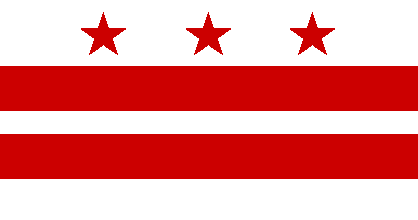
This page is part of © FOTW Flags Of The World website
District of Columbia (U.S.)
Washington, D.C.
Last modified: 2004-12-22 by rick wyatt
Keywords: district of columbia | united states | washington dc |
Links: FOTW homepage |
search |
disclaimer and copyright |
write us |
mirrors
 by Phil Nelson, 24 November 2002
by Phil Nelson, 24 November 2002
See also:
Description of the Flag
On June 16, 1938, Congress passed Public Law 650 authorizing a flag commission "to procure a design for a distinctive flag for the District of Columbia." The commission consisted of the following:
- Melvin C. Hazen, President of the Board of Commissioners
- the Secretary of War, represented by Captain A. D. Hopping of the office of the Quartermaster General
- the Secretary of the Navy, represented by Lt. J.W. Murphy, Jr., Office of Naval Communications
Assisting the commission were:
- A. F. DuBois, Heraldic Section, Quartermaster Corps;
- G. M. Thornett, Secretary of the Board of Commissioners; and the Commission on Fine Arts.
A flag contest was announced to secure a design. On October 15, 1938, the design made by Charles A. R. Dunn was selected for the flag of the District of Columbia. Dunn had first become interested a flag for DC in 1917. At the time
he was employed to do graphics work for the Thomson-Byron-Ellis Company, specifically working on putting together U.S. state flag designs under the direction of Lt. Commander Byron McCandless. This work would become the October 1917 Flag Number of the National Geographic. In this work, the District of Columbia was represented by the DC National Guard flag.
In reviewing the state flags, Dunn was impressed by the flag of Maryland and not impressed by the flags of states that depicted their seals on the flag. Dunn would soon enlist in the Army and it would not be until he returned in 1921 that he drew up a flag proposal, consisting of the coat-of-arms of George Washington (two red bars and three red stars on a white field).
In 1924, there was a brief push to adopt a flag for the District of Columbia. Although short-lived, the Evening Star newspaper published at least two of the proposals it had received. The first, on February 20, was sent by John Mackaye Dunbar and featured the shield of the arms on a red-white-blue field. Although Dunn's proposal was received prior to February 20, it was not published until March 15 and was different from his original drawings in that he used cobalt
blue for the stars instead of red.
The DC Flag Commission decided to include in its search all proposals received prior to 1938 as well as new selections. Dunn sent in his 1921 red-star proposal. The chart he provided also depicted ways the flag could be used in designing flags for local governmental agencies as well as civic organizations.
On August 24, the Evening Star reported  by Phil Nelson, 24 November 2002
by Phil Nelson, 24 November 2002

 by Phil Nelson, 24 November 2002
by Phil Nelson, 24 November 2002